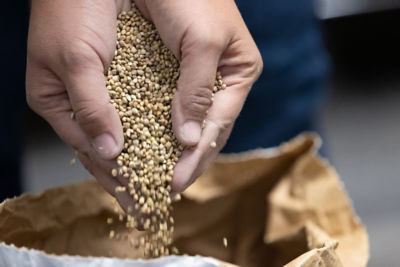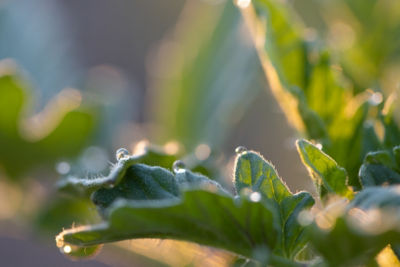» Strategies for managing nematode problems on vegetable crops include avoidance, sanitation, disease resistance, and cultural and chemical measures.
» Initial management efforts should focus on preventing the introduction and spread of nematode pests to new fields.
» Important nematode species vary by crop, geographic area, and soil type.
PLANT PARASITIC NEMATODES
Plant parasitic nematodes are non-segmented roundworms that are obligate parasites, needing living plant tissue to grow and reproduce. Plant parasitic nematodes usually survive as eggs in the soil or plant tissues. Most are soilborne, feeding on or in plant roots, but some colonize and feed on above-ground plant parts, including stems and leaves.1
Root feeding nematodes damage root tissues and disrupt normal root functions. The above ground symptoms of nematode infections, including stunting, yellowing, and wilting, are the result of reduced translocation of water and nutrients. The symptoms can be subtle, and nematode problems are often undetected or overlooked.1 Accurate diagnosis requires an evaluation of colonized tissues characteristic symptoms and the presence of the nematodes.
The nematodes that most commonly cause problems on vegetable crops include root-knot, lesion, dagger, stunt, spiral, stubby-root, lance, pin, cyst, stem, and needle nematodes.1,2 These nematodes vary in their geographic distributions and host ranges and differ in their preferences for certain conditions such as soil types and optimum temperatures.
Root-knot nematodes are the most wide-spread, commonly occurring, and often the most damaging nematodes on vegetable crops. There are over 100 species of root-knot nematodes, and their host range includes agronomic, fruit, vegetable, grass, and weed species.3
NEMATODE SAMPLING
Accurate diagnosis of nematode problems is required to determine the most and effective management strategies. Identification of the pathogen usually requires the sampling of soil or plant tissues to determine the species and population levels of plant parasitic nematodes present, followed by testing of the samples at a diagnostic or soil testing lab.1,4
The best times to take soil samples are before planting in the spring, when nematode populations are at their lowest levels, and after harvest in the fall, when population levels are at their highest. Specific information on methods for sampling, storage, and shipping should be obtained from the lab that will be doing the testing. In general, draw a map of the field to be sampled, indicating soil types, cropping history, injury levels, etc. Divide the area of the field into blocks of five to ten acres. Collect 20 samples from each block using a soil auger or soil sampling tube. Combine the samples from an individual block and mix thoroughly to create a composite sample for each block. Place the soil sample in a plastic bag, and label the outside of the bag with the block number. Keep samples cool (50° to 60°F), and do not leave samples in the sun. Store the samples in a cool place but do not freeze, and send to the testing lab as soon as possible.4
NEMATODE MANAGEMENT
Once plant parasitic nematodes are present in a field, they can be difficult or impossible to eradicate. Therefore, the first management strategy is to avoid fields with a history of nematode problems and undertake efforts to prevent spread of nematodes from infested to non-infested fields. Plant pathogenic nematodes generally do not move far on their own, usually, less than six inches per year. However, they can be transported long distances in anything that moves contaminated soil or infested plant tissue, such as machinery, nursery stock, transplants, animals, and water flowing through a field.1 Sanitation of field equipment and planting non-infected transplants will limit the spread of the nematodes1,2
Because plant parasitic nematodes are obligate parasites, rotation to non-host crops can help to reduce population levels of the nematodes in the soil. However, some nematode species can infect and reproduce on a wide range of hosts, including weed species, and can survive as eggs in the absence of a susceptible host for several years, limiting the effectiveness of crop rotation. If cover crops are included in the rotation, it is important to select species that are non-hosts or poor hosts.2
Organic matter amendments and green manures have been shown to reduce nematode populations in some cases. Butryric acid released from decomposing rye and timothy-grass and isothiocyanates released from Brassica crops can lower populations. However, not all nematodes respond to soil amendments in the same way. Rapeseed amendments can suppress dagger nematodes but not lesion nematodes.2

The use of physical methods, such as the application of heat, steam, and flooding, also can be used to lower nematode populations, especially in greenhouse production systems. Heating soil with steam to a temperature of 158°F for 20 minutes to a depth of 14 inches has been shown to effectively manage nematode problems, but this practice requires special equipment, and the logistics of application may not be practical.5 One method that is currently receiving a lot of attention is anaerobic soil disinfestation (ASD). ASD is a process in which low oxygen conditions are induced by adding quickly decomposable organic matter to soil, covering the amended soil with plastic mulch, and irrigating the soil to the point of saturation. The organic matter used is often a material that is inexpensive and readily available in the area, such as rice bran, rapeseed cake, chicken litter, and molasses.5,6
Host resistance to some nematode species is available in some commercial vegetable varieties. For example, resistance to root-knot nematode is available in varieties of pepper, tomato, and sweet potato.2 Grafting susceptible varieties on to nematode resistant root stocks has also been shown to effectively control nematode problems in some vegetable crops including tomato, pepper, muskmelon, watermelon, cucumber, and eggplant.5
CHEMICAL CONTROL
Soil fumigation involves the application of chemicals to the soil prior to planting. Fumigation products are composed of small, volatile molecules that become gasses upon application and disperse through air spaces in the soil. Fumigants can be applied to entire fields or to strips under plastic-mulched planting beds. Proper soil conditions, including temperature, moisture, and seedbed preparation, are critical for the treatments to be effective. Fumigants commonly used for nematode control include 1,3-dichloropropene (Telone® II Soil Fumigant, Telone® C-17 Soil Fungicide) and sodium methyldithiocarbamate (Metam 426, Vapam® Soil Fumigant Solution for All Crops, Sectagon-42 Agricultural Fumigant, and others). Registrations and use restrictions for these products vary from state to state and can change from year to year. Therefore, it is important to carefully read the most current product labels and carefully follow all label requirements and recommendations.1,2,7
Non-fumigant nematicides (Table 1) do not volatilize in the soil and usually have a narrower spectrum of activity. Some of these products can be applied at or after planting.1,2
SOURCES
1 Warner, F. and Bird, G. Nematodes in commercial vegetables: nematodes of importance in vegetable production. Michigan State University. https://pestid.msu.edu/nematodes-in-commercial-vegetables/.
2 Mulrooney, B. 2014. Nematode control suggestions for vegetables. University of Delaware, Cooperative Extension. https://extension.udel.edu/fieldcropdisease/2014/09/26/nematodecontrol- suggestions-for-vegetables/.
3 Mitkowski, N.A. and G.S. Abawi. 2003. Root-knot nematodes. The Plant Health Instructor. DOI:10.1094/PHI-I-2003-0917-01. Revised 2011.
4 UC pest management guidelines. Agricultural pests. UC IPM nematode information. https://www2.ipm.ucanr.edu/agriculture/.
5 Kokalis-Burelle, N., Iriarte, F., Butler, D., Hong, J., and Rosskopf, E. 2014. Nematode Management in Florida Vegetable and Ornamental Production. Outlooks on Pest Management. 25. 10.1564/v25_aug_10.
6 Shrestha, U., Wszelaki, A., and Butler, D. 2014. Introduction to anaerobic soil disinfestation as a fumigant alternative. University of Tennessee Extension, SP 765-A.
7 Becker, J., Chism, W., Donaldson, D., Kaul, M., and Kiely, T. 2005. Use and usage of soil fumigants: Methyl bromide, chloropicrin, 1, 3-dichloropropene, metam sodium, metam potassium, dazomet. U.S. Environmental Protection Agency Office of Pesticide Programs, Biological and Economic Analysis Division.
8 Reiners, S., Wallace, J., Curtis, P., Helms, M., Landers, A., McGrath, M., Nault, B., and Seaman, A. 2018. Cornell Integrated Crop and Pest Management Guidelines for Commercial Vegetable Production. Cornell Cooperative Extension.
9 Egel, D., Foster, R., Maynard, E., Weller, S., Babadoost, M., Nair, A., Rivard, C., Kennelly, M.,Hausbedk, M., Szendra, Z., Hutchinson, B., Orshinsky, A., Eaton, T., Welty, C., and Miller, S. 2017. Midwest vegetable production guide for commercial growers 2018.
10 Vallad, G., Smith, H., Dittmar, P., and Freeman, J. 2017. Vegetable Production Handbook of Florida 2017-2018. UF-IFSA. Websites verified 10/22/2018.
ADDITIONAL INFORMATION
For additional agronomic information, please contact your local seed representative.
Performance may vary from location to location and from year to year, as local growing, soil and weather conditions may vary. Growers should evaluate data from multiple locations and years whenever possible and should consider the impacts of these conditions on the grower’s fields. The recommendations in this article are based upon information obtained from the cited sources and should be used as a quick reference for information about nematodes and vegetable crops. The content of this article should not be substituted for the professional opinion of a producer, grower, agronomist, pathologist and similar professional dealing with this specific crop.
SEMINIS VEGETABLE SEEDS, INC. DOES NOT WARRANT THE ACCURACY OF ANY INFORMATION OR TECHNICAL ADVICE PROVIDED HEREIN AND DISCLAIMS ALL LIABILITY FOR ANY CLAIM INVOLVING SUCH INFORMATION OR ADVICE. 180626100306110118DME
Seminis® is a registered trademark of Bayer Group. All other trademarks are property of their respective owners. ©2018 Bayer Group. All rights reserved.




